Volvo G6 2005 Owner's Manual
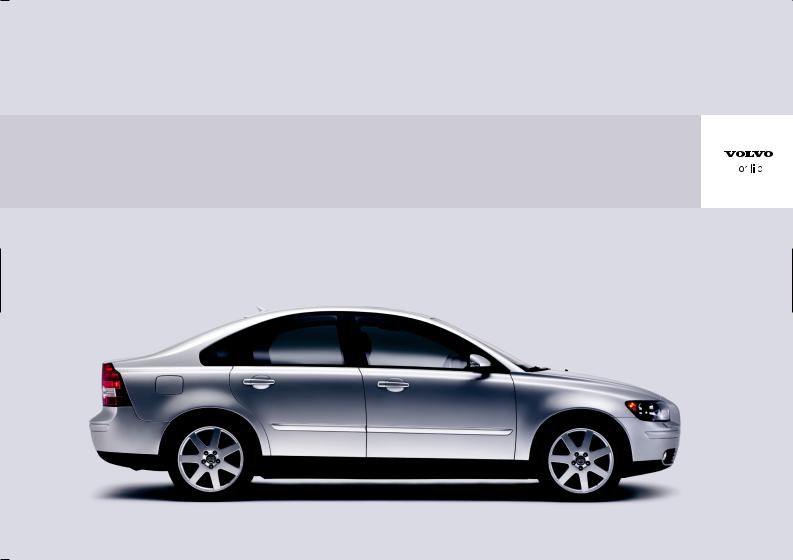
VOLVO
S40
WEB EDITION |
2005 |

Introduction
Dear Volvo owner
We hope you will enjoy many years of driving pleasure in your Volvo. The car has been designed for the safety and comfort of you and your passengers. Volvo is one of the safest cars in the world. Your Volvo has also been designed to satisfy all current safety and environmental requirements.
In order to increase your enjoyment of the car, we recommend that you familiarise yourself with the equipment, instructions and maintenance information contained in this owner’s manual.
Thank you for choosing Volvo!
N

Introduction
Owner’s Manual
A good way of getting to know your new car is to read the owner’s manual, ideally before your first journey. This will give you the opportunity to familiarise yourself with new functions, to see how best to handle the car in different situations, and to make the best use of all the car’s features. Please pay attention to the safety instructions contained in the manual:
for national or local legal requirements and regulations.
The specifications, design features and illustrations in this owner’s manual are not binding. We reserve the right to make modifications without prior notice.
© Volvo Car Corporation
WARNING!
"Warning!" texts indicate where there is a risk of personal injury in the event of the instructions not being followed.
Important!
"Important!" texts indicate a risk of damage to the car in the event of the instructions not being followed.
The equipment described in the owner’s manual is not present in all models. In addition to standard equipment, this manual also describes options (factory fitted equipment) and certain accessories (extra equipment).
NOTE! Volvo cars are adapted for the varying requirements of different markets, as well as
O

Volvo Cars and the environment
Volvo Cars and the environment
Our environmental philosophy
Quality, Safety and Environmental care are the three core values which guide all the activities of Volvo Cars. Volvo cars comply with strict international environmental standards and are manufactured in some of the cleanest and most resource-efficient plants in the world. Volvo Cars has been awarded multi-site global certification under the
ISO 14001 environmental standard, ensuring continuous improvement in the area. All Volvo models are supplied with an environmental product declaration - or EPD - which enables the customer to compare the environmental performance of different models and engines. Visit epd.volvocars.se for more information.
Clean inside and out
Your Volvo is designed to be clean inside and out, a concept which means that you benefit in two ways - from a clean cabin and a highly efficient exhaust treatment system, which ensures that your car saves fuel and releases a minimum of harmful substances.
Inside, the air entering the passenger compartment is filtered to protect you and your passengers from dust, particles and pollen. A sophisticated air quality system known as
IAQS1 can be added as an option to ensure that the air supplied to the passenger compartment is cleaner than the air outside. Consisting of an electronic sensor and an activated carbon filter, the system monitors the
1.Interior Air Quality System
level of carbon monoxide in the incoming air and closes the air intakes to prevent the level in the cabin from becoming too high - for example in heavy city traffic, tailbacks and tunnels - while the carbon filter traps nitrogen oxides, ground-level ozone and hydrocarbons. In addition, to benefit allergy sufferers, the fabrics used in the interior comply with
the provisions of the international Öko-Tex2 standard. Outside, a special catalytic coating
known as PremAir®3 is used to convert harmful ground-level ozone in the air passing through the radiator into pure oxygen.
2.An international ecological standard for textiles
3.Applies only to five-cylinder engines PremAir® is a registered trademark
of Engelhard Corporation |
P |
|
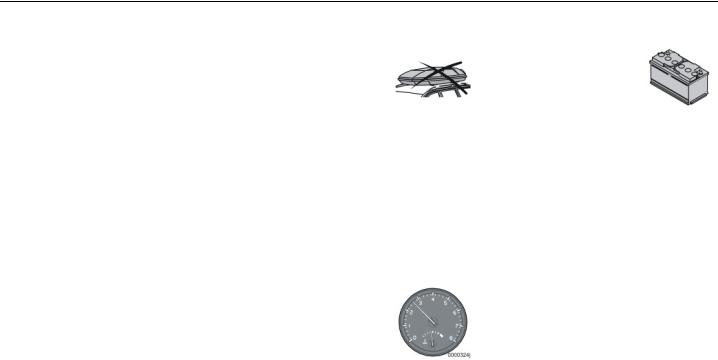
Volvo Cars and the environment
Volvo Cars and the environment
A Volvo meets strict international environmental demands and delivers low fuel consumption to reduce emissions of greenhouse carbon dioxide. In terms of fuel economy, Volvo cars are highly competitive in their respective segments.
Volvo workshops and the environment
Regular maintenance carried out by an authorised Volvo workshop creates the conditions for low fuel consumption and contributes to a cleaner environment. Volvo service technicians are equipped with the knowhow and tools to ensure that your car delivers the best possible environmental performance.
Reducing environmental impact
We believe that our customers share our concern for the environment. You can contribute to improving the environment by using only ecologically approved car care products, and by ensuring that your car is serviced and maintained according to the instructions in the owner's manual.
The following hints will help you to do your bit for the environment:
•Always ensure that your tyre pressures are correct. Poorly inflated tyres increase fuel consumption.
•Since roof racks and ski boxes increase air resistance, leading to significantly higher fuel consumption, they should be removed immediately after use.
•Remove unnecessary items from the car - the greater the load the higher the fuel consumption.
•Is your car equipped with an engine block heater? If so, use it for a few hours before starting from cold to reduce fuel consumption and exhaust emissions.
•Drive gently! Avoid accelerating and braking too hard.
•Drive in the highest possible gear - lower engine revs reduce fuel consumption.
•Ease back on the accelerator on downhill gradients.
•Use engine braking. Take your foot off the accelerator and change down.
•Avoid idling. Switch off the engine in traffic queues.
•Always dispose of environmentally hazardous waste, such as batteries and oils, in an environmentally safe manner. If uncertain, ask
your authorised Volvo workshop for advice.
•Service your car regularly.
These hints will help you to reduce your fuel consumption without increasing your travel time or lessening the enjoyment of driving.
Apart from being kind to your car, you'll be saving money - and the Earth's resources.
Q
|
Contents |
|
|
Instrument overview |
7 |
Safety |
13 |
Instruments and controls |
37 |
Climate control |
65 |
Interior |
77 |
Locks and alarm |
87 |
Starting and driving |
99 |
Wheels and tyres |
131 |
Car care |
149 |
Maintenance and service |
155 |
Infotainment system |
179 |
Technical data |
207 |
R

S

|
Instrument overview |
Overview, left-hand drive car |
8 |
Overview, right-hand drive car |
10 |
Driver’s door control panel |
12 |
T
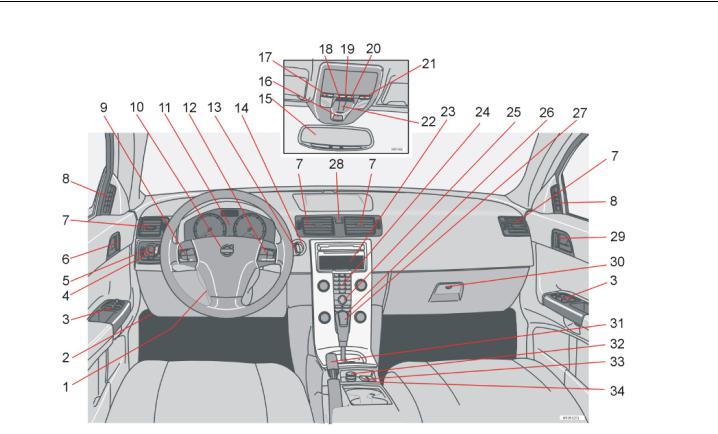
Instrument overview
Overview, left-hand drive car
Left-hand drive
U

Instrument overview
1.Steering wheel adjustment
2.Bonnet release
3.Control panel
4.Direction indicators, main beam, trip computer
5.Lighting, fuel filler flap opener
6.Door handle, central locking
7.Air vents in dashboard
8.Air vent for side window
9.Cruise control
10.Horn, airbag
11.Combined instrument panel
12.Keypad for infotainment system
13.Windscreen wipers and washers, headlamp washers
14.Ignition switch
15.Interior rearview mirror
16.Seatbelt reminder
17.Interior lighting for left-hand side
18.Deactivation of alarm detectors, deadlocks
19.Switch for interior lighting
20.Position of accessory switch
21.Interior lighting for right-hand side
22.Sunroof controls
23.Display for climate control and infotainment system
24.Infotainment system
25.Controls for climate control, infotainment system and personal preferences
26.Climate control
27.Gear lever
28.Hazard warning flashers
29.Door handle
30.Glovebox
31.Parking brake
32.Electrical socket/cigarette lighter
33.STC or DSTC stability system
34.Switch, optional equipment
V
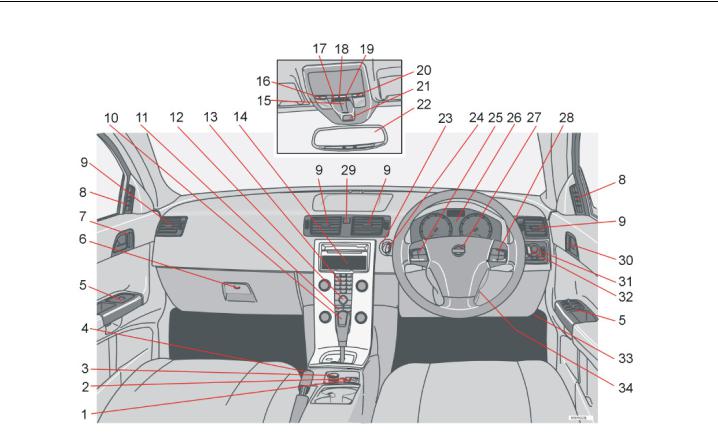
Instrument overview
Overview, right-hand drive car
Right-hand drive
NM

Instrument overview
1.Switch for retrofitted accessory
2.STC or DSTC stability system
3.Electrical socket, cigarette lighter
4.Parking brake
5.Control panel
6.Glovebox
7.Door handle
8.Air vent for side window
9.Air vents in dashboard
10.Gear lever
11.Climate control
12.Controls for climate control, infotainment system and personal preferences
13.Infotainment system
14.Display for climate control and infotainment system
15.Sunroof controls
16.Interior lighting for left-hand side
17.Deactivation of alarm detectors, deadlocks
18.Switch for interior lighting
19.Switch for retrofitted accessory
20.Interior lighting for right-hand side
21.Seatbelt reminder
22.Interior rearview mirror
23.Ignition switch
24.Windscreen wipers and washers, headlamp washers
25.Cruise control
26.Combined instrument panel
27.Horn, airbag
28.Keypad for infotainment system
29.Hazard warning flashers
30.Door handle, central locking
31.Lighting, fuel filler flap opener
32.Direction indicators, main beam, trip computer
33.Bonnet release
34.Steering wheel adjustment
NN

Instrument overview
Driver’s door control panel
1.Blocking switch for rear power windows (standard)
Electric child locks (option)
2.Power windows
3.Door mirror, left-hand side
4.Door mirrors, setting
5.Door mirror, right-hand side
NO

|
Safety |
Seatbelts |
14 |
Airbags (SRS) |
17 |
Activating/deactivating the airbag (SRS) |
20 |
Side airbags (SIPS) |
22 |
Inflatable Curtain (IC) |
24 |
WHIPS |
25 |
When are the safety systems activated? |
27 |
Crash mode |
28 |
Inspecting the airbags and inflatable curtains |
29 |
Child safety |
30 |
NP
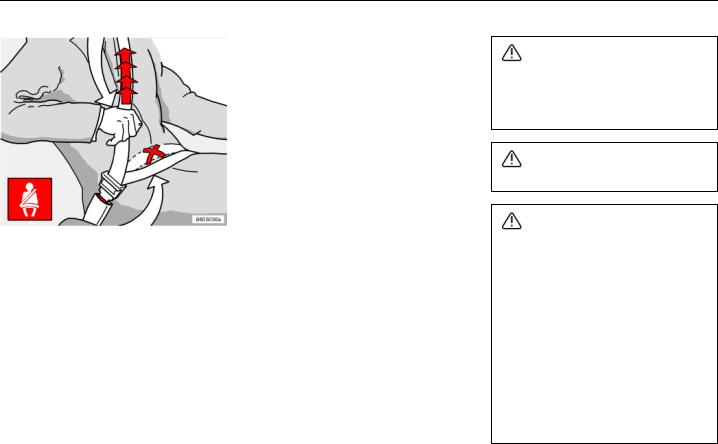
Safety
Seatbelts
Tensioning the hip strap. The belt must be positioned low down.
Always use a seatbelt
Heavy braking can have serious consequences if the seatbelts are not used. Ensure that all passengers use their seatbelts. Otherwise, rear seat passengers may be thrown forward against the backs of the front seats in a collision.
Putting on a seatbelt:
–Pull the belt out slowly and secure it by pressing the buckle into the lock. A loud "click" indicates that the belt has locked.
Releasing the belt:
–Press the red lock button and let the belt retract. If the belt does not retract fully, feed the belt in by hand so that it does not hang lose.
The belt locks and cannot be withdrawn:
•if it is pulled out too quickly.
•during braking and acceleration.
•if the car leans heavily.
It is important that the belt lies against the body so it can provide maximum protection. Do not lean the backrest too far back. The seatbelt is designed to protect in a normal seating position.
Keep the following in mind:
•do not use clips or anything else that can prevent the belt from fitting properly.
•ensure the belt is not be twisted or caught on anything.
•the hip strap must be positioned low down (not over the abdomen).
•tension the hip strap over the lap by pulling the diagonal shoulder belt as illustrated.
WARNING!
The seatbelts and airbags interact. If a seatbelt is not used or is used incorrectly, this may diminish the protection provided by the airbag in the event of a collision.
WARNING!
Each belt is intended for one person only.
WARNING!
If the belt has been subjected to a major load, such as in a collision, the entire belt must be replaced. This includes the reel, mountings, bolts and buckles. Some of the protective characteristics of the belt may have been lost, even if it appears to be undamaged. Replace the seatbelt if the belt is worn or damaged. The new seatbelt must be type-approved and intended for installation in the same position as the replaced belt.
Never modify or repair the seatbelts yourself. Contact an authorised Volvo workshop.
NQ
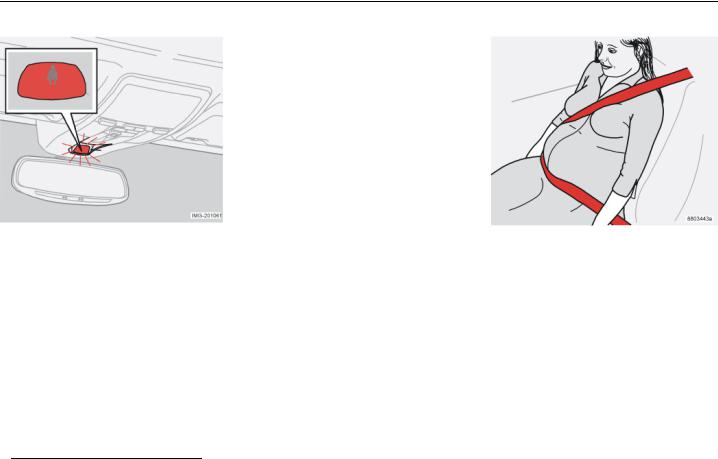
Safety
Seatbelt reminder1
A symbol lights up in the roof console (above the rearview mirror) as a reminder that the seatbelts are not buckled up. A symbol also lights up on the combined instrument panel. If the car is stationary, the reminder is extinguished after approximately six seconds.
Front seat
The symbols remain lit as long as the driver or front seat passenger do not have their seatbelts on. (If a child seat is place on the front seat, the reminder does not come on.) In addition to the two symbols, an audible
1.Function can depend on market
reminder is heard that changes frequency with the speed of the car.
Rear seat
The seatbelt reminder has two sub-functions:
•Notifies of the number of seatbelts being used via a message on the information display. This function is automatically activated as soon as a rear door is opened and closed, even if no one is actually sitting in the rear seat. The message is automatically erased
approx. 10 seconds after the car is driven away, or can be acknowledged manually by pressing the READ button.
•Warns that someone in the rear seat has removed their seatbelt while the car is moving. A message appears on the information display and an audible warning sounds. The warning ceases once the belt has been put back on, or can be acknowledged manually by pressing the READ button.
The message on the display that states how many seatbelts are in use can be viewed at any time. To read saved messages, press the READ button.
Seatbelts and pregnancy
It is extremely important that the seatbelt is used correctly during pregnancy. It should be in contact with the body. The upper part of the seatbelt should fit between the breasts and against the side of the abdomen. The hip section of the seatbelt must be flat and as far under the abdomen as possible. It must not slide up towards the abdomen.
An expectant mother who is driving should move the seat as far back as possible in order to obtain the greatest possible distance between the steering wheel and the abdomen. Set the steering wheel as far forward as a comfortable driving position permits.
NR
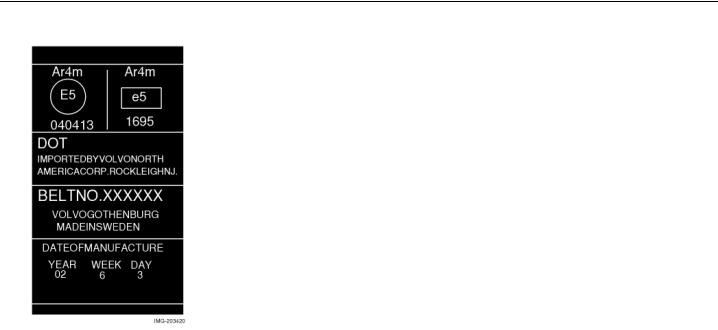
Safety
Seatbelts
Seatbelt tensioner
All the seatbelts (except the centre rear belt) are equipped with belt tensioners. A mechanism in the belt tensioner tightens the belt around the body in the event of a sufficiently violent collision. This provides more effective restraint for passengers.
Label on seatbelts with seatbelt tensioner
NS
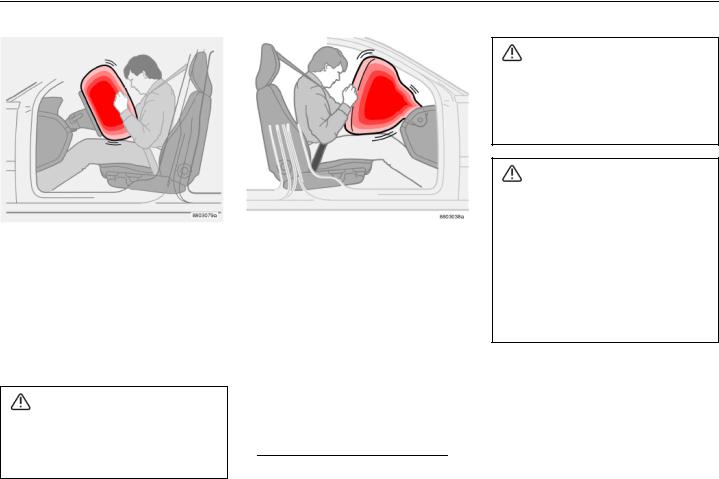
Safety
Airbags (SRS)
Airbag (SRS) on the driver’s side
The car has an SRS airbag (Supplemental Restraint System) in the steering wheel to supplement the protection afforded by the seatbelt. This airbag is fitted into the centre of the steering wheel. The steering wheel is marked SRS AIRBAG.
Passenger airbag (SRS)
The passenger airbag1 is fitted behind a panel above the glovebox. This panel is marked SRS AIRBAG.
WARNING!
The seatbelts and airbags interact. If a seatbelt is not used or is used incorrectly, this may diminish the protection provided by the airbag in the event of a collision.
1.Not all cars have a passenger airbag (SRS). This can be unselected when the car is ordered.
WARNING!
To minimise the risk of injury if the airbag deploys, passengers must sit as upright as possible with their feet on the floor and backs against the backrest. Seatbelts must be secured.
WARNING!
Never place a child in a child seat or on a booster cushion in the front seat if the
airbag (SRS) is activated.1
Never allow a child to stand or sit in front of the front passenger seat. No one shorter than 140 cm (4 ft 7) should sit in the front passenger seat if the airbag (SRS) is activated.
Failure to follow the advice given above can endanger the life of the child.
1.For information on activated/deactivated airbag (SRS), see page 20.
NT
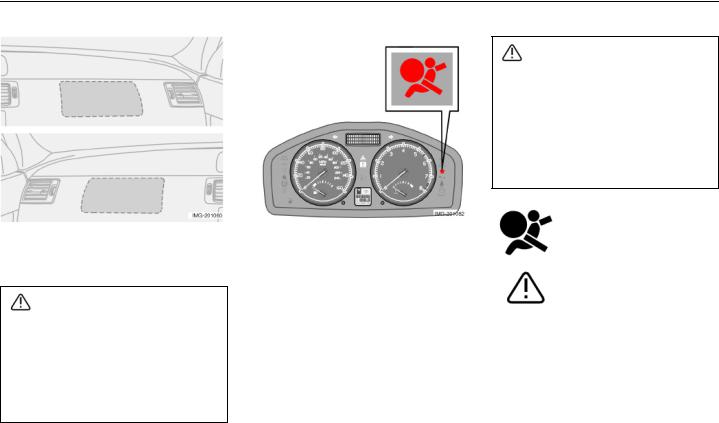
Safety
Airbags (SRS)
Location of the passenger airbag in left-hand drive and right-hand drive cars.
WARNING!
Objects and accessories must not be positioned or glued on or near the SRS AIRBAG panel (above the glovebox) or in the area affected by a deployed airbag. Never interfere with SRS components in the steering wheel or the panel above the glovebox.
Warning symbol on the combined instrument panel
The AIRBAG system is monitored continuously by the car’s electronic control system. The warning symbol on the combined instrument panel lights when the ignition key is turned to position I, II or III. The symbol goes out after about six seconds if the AIRBAG system is working correctly.
WARNING!
If the warning symbol for the AIRBAG system remains on or comes on while driving, it means that the AIRBAG system is not functioning fully. The symbol can indicate a fault in the seatbelt buckle, SIPS, SRS or IC system. Contact an authorised Volvo workshop immediately.
As well as the warning symbol, a message appears on the information display. If the warning symbol malfunctions, the warning triangle comes on and the message SRS AIRBAG SERVICE URGENT appears on the display.
Contact an authorised Volvo workshop immediately.
NU

Safety
SRS system, left-hand drive
SRS system
The SRS system consists of a gas generator surrounded by an inflatable airbag. A sufficiently violent collision trips sensors and ignites the gas generator, inflating the airbag with hot gas. To cushion the impact, the airbag deflates when compressed. When this occurs, smoke escapes into the car. This is completely normal. The entire process, including inflation and deflation of the airbag, occurs within tenths of a second.
SRS system, right-hand drive
NOTE! The sensors react differently depending on the course of the collision and whether the seatbelts on the driver and passenger side are used. It is therefore possible that only one (or none) of the airbags may inflate in a collision. The SRS system senses the force of the collision on the car and adapts accordingly so that one or more airbags is deployed.
WARNING!
Work on the SRS system can cause malfunction and result in serious personal injury.
Repairs must only be performed by an authorised Volvo workshop.
Airbags (SRS)
NOTE! The airbags have a function whereby their capacities are adapted to the collision force to which the vehicle is subjected.
NV
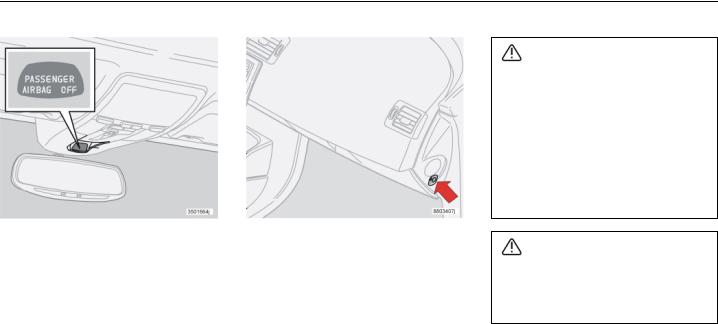
Safety
Activating/deactivating the airbag (SRS)
Indicator showing that the passenger airbag (SRS) is deactivated.
PACOS (option)
The airbag (SRS) for the front passenger seat can be deactivated. This is necessary if a child seat is to be placed there.
Indicator
A text message on the roof panel indicates that the passenger airbag (SRS) is deactivated.
PACOS (Passenger Airbag Cut-Off Switch)
Activating/deactivating
The switch is located on the passenger end of the dashboard and is accessible when the passenger door is open. Check that the switch is in the required position. Volvo recommends that that the ignition key is used to change position. (Other items with a shape similar to a key can be used.)
WARNING!
Activated airbag (passenger seat): Never place a child in a child seat or on a booster cushion in the front passenger seat. This also applies to persons shorter than 140 cm (4 ft 7).
Deactivated airbag (passenger seat): Persons taller than 140 cm (4 ft 7) must never sit in the passenger seat.
Failure to follow the advice given above can endanger life.
WARNING!
If the car is equipped with a front passenger airbag (SRS), but does not have PACOS, the airbag will always be activated.
OM

Safety
Switch for SRS in ON position.
Switch position
ON = Airbag (SRS) activated. With the switch in this position, persons taller than 140 cm (4 ft 7) can sit in the front passenger seat, but never children in a child seat or on a booster cushion.
Switch for SRS in OFF position.
OFF = Airbag (SRS) is deactivated. With the switch in this position, children in a child seat or on a booster cushion can sit in the front passenger seat, but never persons taller than 140 cm (4 ft 7).
WARNING!
Do not allow anyone to sit in the front passenger seat if the text message in the roof panel indicates that the airbag (SRS) is deactivated and the airbag warning symbol is displayed in the combined instrument panel. This indicates that there has been a severe malfunction. Contact an authorised Volvo workshop as soon as possible.
ON
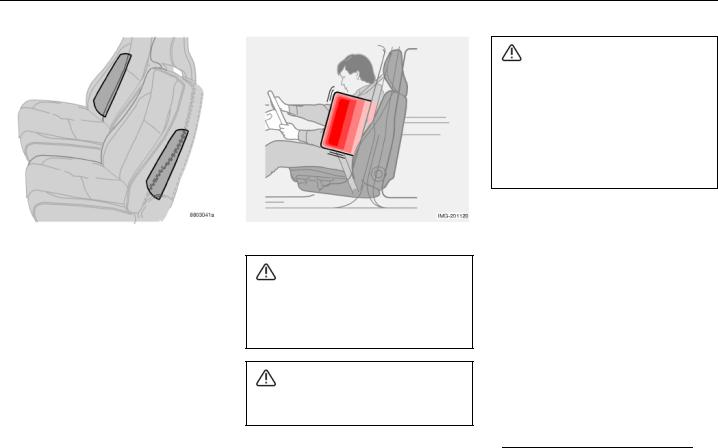
Safety
Side airbags (SIPS)
Side airbag locations.
Side airbags — SIPS bags
A large proportion of the collision force is transferred by the SIPS to the floor, roof, beams, pillars, and other structural parts of the body. The side airbags on the driver and front passenger seats protect the chest area and are an important part of the SIPS. The SIPS bag system consists of two main parts: The side airbags and the sensors. The side airbags are located in the front seat backrests.
WARNING!
Use only Volvo genuine car seat covers, or seat covers approved by Volvo. Other seat covers may impede the operation of the side air bags.
WARNING!
Side airbags are a supplement to the SIPS system. Always wear a seatbelt.
WARNING!
Work on the SIPS bag system can cause malfunction and result in serious personal injury. Always contact an authorised Volvo workshop.
Do not put objects in the area between the outside of the seat and the door panel, since this area is required by the side airbag.
Child seats and side airbags
The side airbag does not diminish the protection provided by the car to children seated in a child seat or on a booster cushion.
A child seat or booster cushion can be placed on the front passenger seat provided
that the car does not have an activated1 passenger airbag.
Side airbags are a supplement to the SIPS system. Always wear a seatbelt.
1.For information on activated/deactivated airbag (SRS), see page 20.
OO

Safety
Left-hand drive |
Right-hand drive |
SIPS bag system
The SIPS bag system consists of a gas generator, side airbag and sensors. A sufficiently violent collision trips the sensors and ignites the gas generator, inflating the side airbag. The airbag inflates between the occupant and the door panel and thereby cushions the initial impact while deflating. The side airbag is only normally deployed on the side of the collision.
OP
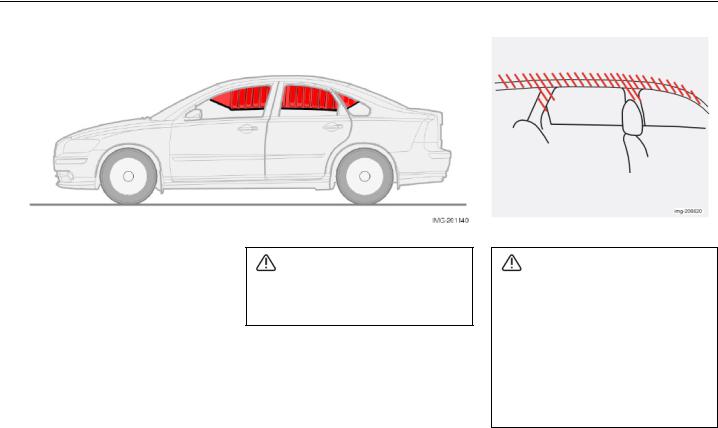
Safety
Inflatable Curtain (IC)
Properties
The inflatable curtain is a supplement to the SIPS system. It is concealed in the headlining along both sides of the roof and protects both front and rear seat passengers. The inflatable curtain is activated by the SIPS collision sensors if the car is hit from the side. When deployed, the inflatable curtain inflates. The inflatable curtain helps to prevent the driver and passengers from striking their heads on the inside of the car during a collision.
WARNING!
The inflatable curtain is a supplement to the seatbelts.
Always use a seatbelt.
WARNING!
Never hang or fasten anything on the roof handles. The hook is only intended for light outer garments (not for hard objects such as umbrellas).
Do not screw or fit anything to the headlining, door pillars or side panels. This could compromise the intended protection. Only use Volvo genuine parts that are approved for placement in these areas.
OQ
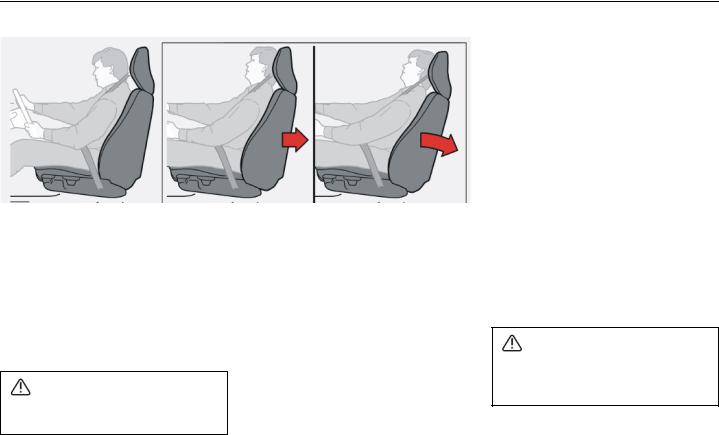
Safety
WHIPS
Protection against whiplash injury — WHIPS
The whiplash protection system (WHIPS) consists of energy absorbing backrests and specially designed head restraints for the front seats. The system is actuated by a rearend collision, where the angle and speed of the collision, and the nature of the colliding vehicle all have an influence.
WARNING!
The WHIPS system is a supplement to the seatbelts. Always wear your seatbelt.
Properties of the seat
When the WHIPS system is deployed, the front seat backrests fall backward to alter the position of the driver and front seat passenger. This diminishes the risk of whiplash injury.
WHIPS system and child seats/ booster cushions
The WHIPS system does not diminish the protection provided by the car to children seated in a child seat or on a booster cushion.
WARNING!
Never modify or repair the seat or WHIPS system yourself. Contact an authorised Volvo workshop.
Correct seating position
For the best possible protection, the driver and front seat passenger should sit in the
OR
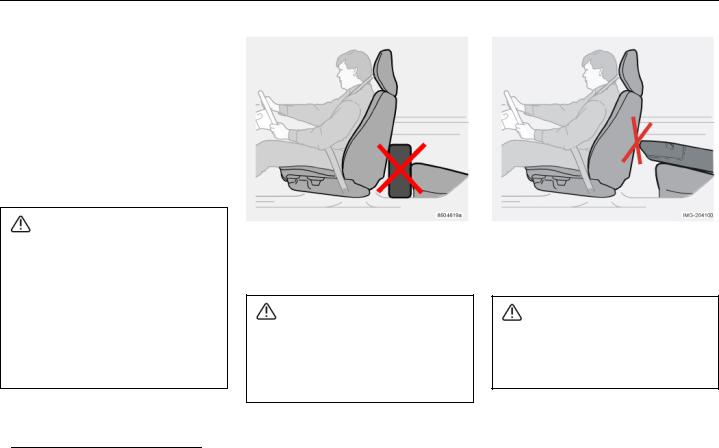
Safety
WHIPS
centre of the seat with as little space as possible between the head and the head restraint.
You may place:
•a child seat or booster cushion on the front passenger seat, provided the passenger airbag is not activated1.
•a rear-facing child seat in the rear seat that uses the back of the front seat as support.
WARNING!
If a seat has been subjected to extreme forces, such as due to a rear collision, the WHIPS system must be checked by an authorised Volvo workshop.
Part of the WHIPS system’s protective capacity may have been lost even if the seats appear to be
undamaged. Contact an authorised Volvo workshop to have the system checked even after a minor rear-end collision.
Do not obstruct the WHIPS system
WARNING!
Do not squeeze rigid objects between the rear seat cushion and the front seat backrest. Make sure you do not to obstruct the function of the WHIPS system.
WARNING!
If a rear seat backrest is folded down, the corresponding front seat must be moved forward so that it does not touch the folded backrest.
1.For information on activated/deactivated airbag (SRS), see page 20.
OS
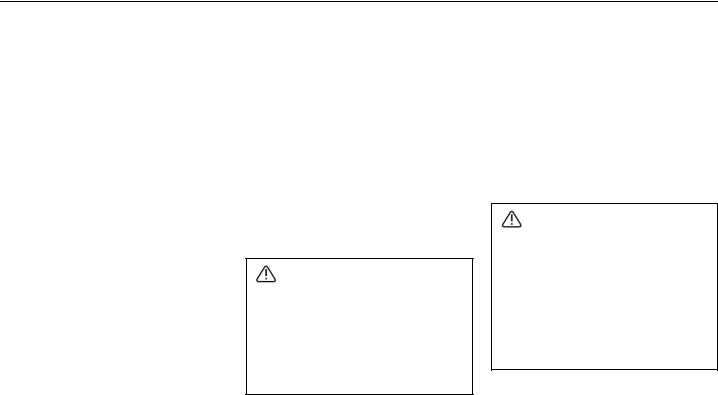
Safety
When are the safety systems activated?
System |
Triggered |
|
|
Seatbelt tensioner |
In a frontal collision and/or side-impact accident. |
Airbags (SRS) |
In a frontal collision.1 |
Side airbags (SIPS) |
In a side-impact accident.1 |
Inflatable curtains |
In a side-impact accident.1 |
Whiplash protection WHIPS |
In a rear-end collision. |
1.Airbags do not always deploy during a collision. The particular impact may not require the function, with the car’s other safety systems providing occupants adequate protection.
If the airbags have been deployed, the following is recommended:
•Have the car transported to an authorised Volvo workshop. Do not drive with deployed airbags.
•Let an authorised Volvo workshop replace components in the car’s safety system.
•Always contact a doctor.
NOTE! The SRS, SIPS, IC and belt tensioner systems are deployed only once during a collision.
WARNING!
The AIRBAG control unit is located in the centre console. If the centre console is drenched with water or other liquid, disconnect the battery cables. Do not attempt to start the car since the airbags may deploy. Have the car transported to an authorised Volvo workshop.
WARNING!
Never drive with deployed airbags. They can make steering difficult. Other safety systems may also be damaged. The smoke and dust created when the airbags are deployed can cause skin and eye irritation after intensive exposure. In case of irritation, wash with cold water. The rapid deployment sequence and airbag fabric may cause friction and skin burns.
OT
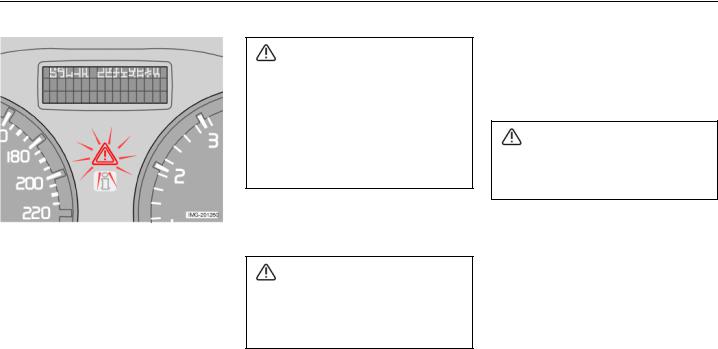
Safety
Crash mode
Driving after a collision
If the car is involved in a collision, the text CRASH MODE – SEE MANUAL may appear on the information display. This means that the car has reduced functionality. CRASH MODE is a protective state that is enforced when the collision may have damaged the car’s vital functions, such as the fuel lines, sensors for one of the safety systems, or the brake system.
WARNING!
Never attempt to repair your car or reset the electronics yourself if the car has been in CRASH MODE. This could result in personal injury or the car not functioning as normal. Always allow an authorised Volvo workshop to check and restore the car to normal status after CRASH MODE has been displayed.
Attempting to start the car
First, check that no fuel is leaking from the car. There should be no smell of fuel.
WARNING!
Never, under any circumstances, attempt to restart the car if it smells of fuel when the CRASH MODE message is indicated. Leave the car at once.
If everything seems normal and you have checked for indications of fuel leakage, you may attempt to start the car.
•Firstly, remove the ignition key and then reinsert it. The car’s electronics will now try to reset themselves to normal mode.
Then try to start the car. If CRASH MODE
is still shown in the display then the car must not be driven or towed. Even if the car appears to be driveable, hidden damage may make the car impossible to control once moving.
WARNING!
If the car is in CRASH MODE it must not be towed. It must be transported to an authorised Volvo workshop.
Moving the car
If NORMAL MODE is shown after CRASH MODE has been reset, the car can be moved carefully out of a dangerous position. Do not move the car further than necessary.
OU
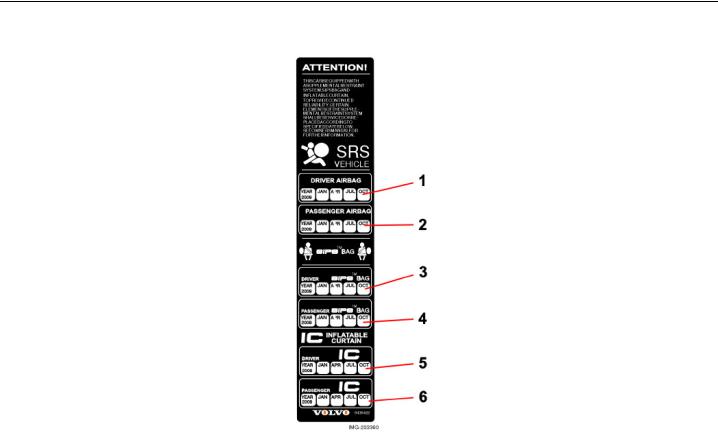
Safety
Inspecting the airbags and inflatable curtains
Inspection intervals
The decal on the door pillar(s) shows the dates (year, month) when you should contact an authorised Volvo workshop to inspect and, if necessary, replace the airbags, belt tensioners and inflatable curtains. If you have questions concerning the systems, contact an authorised Volvo workshop.
1.Driver airbag
2.Front passenger airbag
3.Side airbag on the driver’s side
4.Side airbag on the passenger side
5.Inflatable curtain on the driver’s side
6.Inflatable curtain on the passenger side
This decal is located in the rear left door opening.
OV
